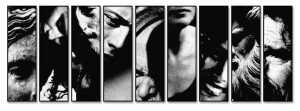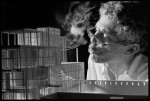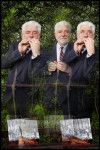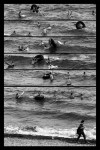Dear Readers of LeonardoVfashionbook we would like to introduce you today to Riccardo Pieroni one of Italy ‘ s most significant Photographers
RICCARDO PIERONI
He was born in Rome in 1955. In 1977, he co-founded the Cooperativa Città del Sole, which works out new strategies and techniques aimed at the teaching methodology of cultural heritage. In that period, he turned to professional photography, became fond of graphics and dedicated himself to the care and fitting of exhibitions. He has taught Photographic technique and Digital processing of images, since 1987 and 2000 respectively, at the Istituto di Stato per la Cinematografia e la Televisione “Rossellini” in Rome. Alongside the institutional teaching, he developed the Workshops of photograhic imagination, held in community centres, museums, schools of all categories and degrees and during cultural events. His professional and artistic activity focuses on both photography and graphics, trying to mix them up through the development of pubblications and productions.His personal search regards the themes of space, time, light, memory, anthropology and portrait. The connective tissue is the photographic library in form of physical memory, from which new and infinite looks can be taken. Pieroni wrote several books about photography, in which he synthesizes its historical, technical and expressive features in pursuit of describing the particular linkage between reality and imagination that is implicit in taking pictures. 
Pieroni Riccardo interviews Riccardo Pieroni Riccardo Pieroni will be sixty years old this year and he has been devoting forty of them to photography. His generation immediately followed that of Italian photographers-phylosophers (such as Gabriele Basilico, Mimmo Jodice or Luigi Ghirri, all of whom owed Ugo Mulas the revolution of the photographic process, carried out through his “Tests”). Since the early days Riccardo Pieroni, who is by nature prone to deal with the essence of things, has followed his own way, where photography always goes hand in hand with manual skills and thought. We met him at his studio-house in Maccarese. P.R. What kind of relationship do you have with photography? R.P. When I was child, I spent my days playing in the streets, going to school and drawing. My father used to bring home some paper blocks that I used for figure-drawing or self-made fantasy comics. As a teenager, I began to paint in distemper and oils. Above all landscapes. However, the painting process seemed too slow to me, as I had to wait too much from the conception to the realization of the idea: the layers of colour needed to dry off and the brush flowed irregularly. When I was in high school, some of my schoolmates took pictures, so I understood that photography could be a quick technique to create images without losing manual skills, which are my personal way to deal with the world. I used plywood and aluminium to build my first enlarger and became keen on black & white printing. While I was studying architecture at university, I understood that photography involved significant questions about the representation of space and I began to use it in order to replace drawing in the designing stage. That became my way of dealing with different problems relating to communication. Thus, when I founded the Cooperativa Città del Sole (which regarded the teaching methodology of the land and the cultural heritage) together with some friends of mine, I became a professional photographer. My job spontaneously grew up through the mixture of photography, graphics and teaching methodology. However, I felt the need to develop alongside the “useful” and professional photography an analogous activity, through which I could verify the language that has made me more and more aware of the expressive potential of photography. In my opinion, “the” photography does not exist, but there are many different ways of producing and using photographs. I always take my camera with me. I take pictures of everything and in different ways. I think that the picture itself is “made” many times, when taken, when printed, when preserved, when filed, when watched. Each time it revives and turns into a never-ending and creative connection with what we are in a specific moment of our life. My memory lives inside the photographic library and materializes itself in different shapes according to new backgrounds. For this reason, I keep thinking about the uncertainty of our existence and the constant effort to find a harmonious balance between our past and our future. P.R. Tell us about portraits. R.P. My tack is connected with the representation of space, more specifically perspective. I think that people live, move and show themselves inside space; they are part of the environment, which is made of limits, objects and actions. They fill the space just as they fill a photographic rectangle. The artists I shot are already inclined to accept this relationship, as it is part of their being and their work. I generally accept the situation I find and then I try to understand what kind of relationship could be created with the subject: it is a matter of choices and balance. This is the origin of a photograph. In the series Occhi (che molto hanno visto) (Eyes that saw a lot) the bodies are immersed in the pictures; the imagination of each director emerges and becomes a space external to itself.
- Francesca Cataldi, artista, 1993; Photographer Riccardo Pieroni
- Maurizio Montani, architetto, 1998; Photographer Riccardo Pieroni
- Sandro Prayer, artista,1995; Photographer Riccardo Pieroni
- Jens Sabber, artista, 1996; Photographer Riccardo Pieroni
- Emilio Puglielli, architetto, 1992; Photographer Riccardo Pieroni
- Toni Bottan (Nonno Toni), bracciante agricolo costruttore di giochi, 2008; Photographer Riccardo Pieroni
- Leonardo Vecchiarelli, fotografo, 2007Photographer Riccardo Pieroni
- Hannu Hautala, fotografo, 2012Photographer Riccardo Pieroni
- Patrizia Chiozza e Fabrizio Carbone, naturalisti, 2012; Photographer Riccardo Pieroni
- Michele Carnevali, maestro di ocarina, 2012; Photographer Riccardo Pieroni
- Massimo Palumbo, architetto e artista, 2013; Photographer Riccardo Pieroni
- Occhi (che molto hanno visto), Ugo Gregoretti, regista, 2007; Photographer Riccardo Pieroni
- Occhi (che molto hanno visto), Carlo Lizzani, regista, 2006; Photographer Riccardo Pieroni
P.R. Whom do you like to portray? R.P. I am a shy person, the camera is my hideout and my mask. I like to portray anyone, as long as he/she wants so! In a portrait, I do not like to steal images. When I take a snap all at once, the subject is anyhow aware that something is going to happen. The portrait is a mixture of traps, waits, escapes… An escape in hopes of being caught. At the end, everyone is satisfied. I like to take pictures of my students, or friends. They do not see the pictures I took for years and then, all of a sudden, these appear unexpected and by then forgotten, so life becomes a discovery. Many people break down. They cry. A photograph is a disclosure, a mirror delivered to another person in order to give sense to our life at a later date. The photographer needs to be trusted by his subjects. When I portray the artists I work with, my photograph represents a thank-you for their job and a personal interpretation of their way of being in the world. I do not talk much; the images are a way to show synthetically what I think about a person. It is a testing ground that compels me to meditate and then tell. P.R. If we look at the portraits you realized, they do not seem to have a common style. R.P. We are all different; difference is what makes us equal. Why should not photographs follow the same destiny? I like to face situations and then develop the method I deem most appropriate in that moment. It is an exercise to stay always awake. P.R. It seems to me, though, that there are some constants, rather than a style… an attitude. R.P. I wish I were one of those photographers able to represent the “true” essence of a subject in one snap. It would calm me down! Nevertheless, how could you think of such a thing? Life is change… and effort to preserve the harmony. For this reason, I introduce dynamic elements inside the framing, exaggerate the point of view, use overlapping and fade or put images together in a polyptych. Balance is not a starting point: it is an arrival point. I slowly understood that the real parameter of photography is not space, but time! P.R. Did this awareness produce any changes in your way of taking pictures? R.P. My first experiences in testing the photographic language represent a meditation on the building procedure of the shot. At this stage, I begin to deal with the photographic shooting as a serial action: it does not matter the single “shot”, but the way of approaching reality. I stand still in a point, my “point of view”, and I observe. Each click strikes the time of the view. Each moment, senseless in itself, achieves a raison d’être in a long time, an overview that forms the story. The following stage regards the use of the library: the thousands of pictures I took make up my “physical memory”. I see, but not everything and not immediately. Moving throughout the library, I can see a new world going deeper into it, a partly independent world that gains awareness only when the “search” begins. Therefore, the pictures taken while travelling or those taken just for “recording” become meaningful. Therefore, the search in the library is a real search for a meaning, a direction for all the possible gazes. Each “negative” contains a world ready to be discovered, infinite and crystallized pictures that can be “framed”, split and disclosed again. The best tools for this search are the polyptych, the book and now also the video, which I consider as preferential ways of expression for my artistic search. In this long-time view, I have recently reappraised the deep sense and symbolic value of the single shot, the lonely picture. Only now, I can see in that picture the fleeting synthesis of all the others and try to give it the final meaning of a more complex work. In this way, my work moves towards four complementary directions at the same time. The build-up process leads to the polyptych, the removal process leads to the single picture, the creation of meaningful backgrounds leads to the book, the transformation process leads to the video. This involves working with time and inside time! P.R. Let us talk about polyptychs. R.P. I reached this form of expression almost naturally. Only afterwards, I understood that I had assimilated all the tradition of art history that conceptualized assertive and discussing artworks, such as the great cycles of frescoes or the altarpieces composed by several pictures individually framed, but still forming a single entity. My polyptychs are made of many pictures, even several dozens of them. The polyptych can reach huge dimensions: the observer can only read it by moving in the space. Indeed, the polyptych itself is a space in which moving. It requires a total view that makes you appreciate the unitary logic and a short-distance interpretation that let you explore any detail in order for the artwork to link with the observer and use its attention/intention and its memory to give the picture a meaning. The polyptych gives me the opportunity to work on the seriality of looks, the repetition of images that are only apparently identical, but contain each one its own individuality, instead.I usually choose the subjects among the most common (and for this reason, never watched) things: photography is “disclosure”. For each subject I create a different recording technique: the “traditional” photography in studios or external places is supported by the scanner used as a camera and the photography with no device, where only the light, which covers the sensitive material in extremely long times, has effect. A good deal of manual skills is anyhow involved: photography is an “object to build”. I deal with the impossible task (as far as I know) to classify the world and its changes across time. Photography is a work of “meditation”.
- Festa de noantri in Trastevere, Roma, 197902_02. MENT IRE . Viaggio nell’archivio urbano,1996, cm 78×780 (72 fotografie cm 24×30,5); Photographer Riccardo Pieroni
- MENT IRE . Viaggio nell’archivio urbano,1996, cm 78×780 (72 fotografie cm 24×30,5) part; Photographer Riccardo Pieroni
- MENT IRE . Viaggio nell’archivio urbano,1996, cm 78×780 (72 fotografie cm 24×30,5) part ; Photographer Riccardo Pieroni
- Talassometrie. Cinquanta metri di mare al Lido di Capo Portiere, 1997, cm 96×760 (54 fotografie cm 30×40) part.; Photographer Riccardo Pieroni
- TRASFORMAZIONI 06, Danimarca, 1997; Photographer Riccardo Pieroni
- PAESAGGI UMANI 03, 2007, (9 fotografie cm 30×103) ; Photographer Riccardo Pieroni
- Resti di un chiosco di bibite a Trinità dei Monti, 1999, cm 85×208 (15 fotografie cm 27×40);Photographer Riccardo Pieroni
- Spighe al vento su Viale dei Tre Denari, 30.5.2014, ore 17:23, cm 98×190 (12 fotografie cm 30×45); Photographer Riccardo Pieroni
- MONDI VICINISSIMI 08, 2001, cm 236×105 (7 fotografie cm 32×105); Photographer Riccardo Pieroni
- I semi di una fetta di cocomero mangiata a Mugnano il 30.08.1996, 1996, cm 126×300 (48 fotografie cm 30,5×24); Photographer Riccardo Pieroni
- Sette aghi di pino, 1996-2000, cm 222×45 (7 fotografie cm 30×45); Photographer Riccardo Pieroni






















